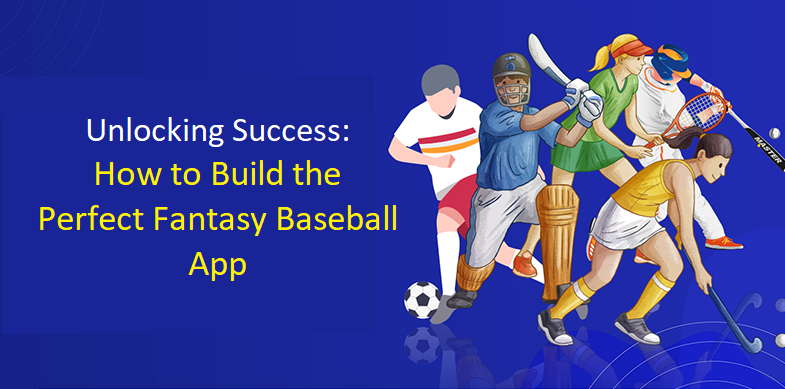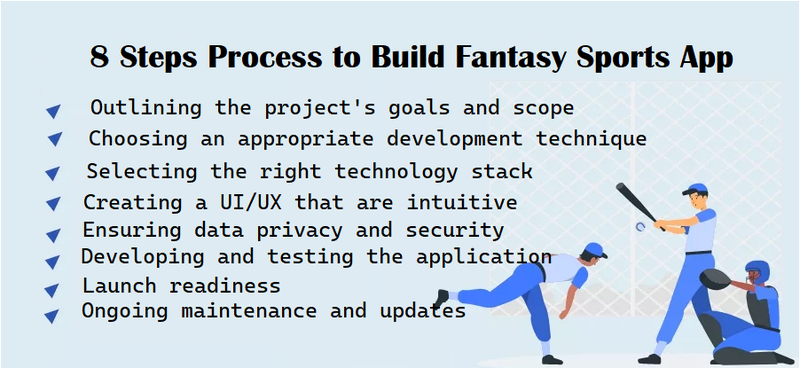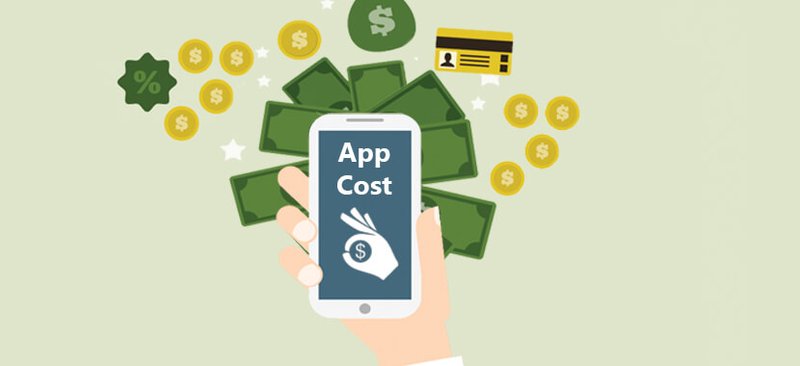Unlock Success: Building the Perfect Fantasy Sports App in 2023
Fantasy sports have grown in popularity in recent years, with over 60 million individuals in the United States and Canada alone engaging in sports such as football, basketball, and esports. Fantasy sports have evolved as a popular favorite among these sports, grabbing the imaginations of both casual and die-hard fans. The fantasy sports business was anticipated to be worth more than $20 billion in 2021, and the figures are only expected to rise. As the popularity of fantasy sports grows, the necessity for a user-friendly and feature-rich fantasy sports league app becomes increasingly important. A well-designed app not only engages users but also allows them to stay connected to their favorite sport and compete with friends and fellow fans all around the world.

We will go into the construction and features of a bespoke fantasy sports app in this complete tutorial, concentrating on mobile app development, critical app features, app development expenses, and selecting the best mobile app development business. In addition, we will share insights into the most recent trends and data to assist you in making educated decisions while designing your app. Prepare to hit a home run with your very own fantasy sports app!
Fantasy Sports app– Market Size and Stats

Regarding daily fantasy sports platforms and applications, the following are some eye-opening statistics and market summaries:
- According to the Fantasy Sports & Gaming Association, the yearly income from the fantasy sports market in the US is estimated to be over $7 billion.
- In the USA, 69% of fantasy gamers earn more than $40,000, while 48% are between the ages of 18 and 34.
Traditional sports like basketball, baseball, and football are not the only ones available in the fantasy sports market. The most recent fantasy applications for horse racing, esports, and cricket is becoming more and more popular.
Must-Have Features of Fantasy Sports App

Incorporating a variety of features that serve the target market's interests and improve the user experience is key to developing a successful fantasy sports app. When creating a fantasy sports app, the following crucial features should be taken into account:
A. User registration and profile management
Any app must have a quick and safe user registration procedure. Provide options for consumers to register using their email, social network accounts, or cellphone number. Users should be able to establish and manage their profiles, upload profile images, and adjust settings after they have registered.
B. Customizable draft and team management
To accommodate a range of user preferences, provide a selection of draught formats, such as snake, auction, and slow draughts. Users should be able to make and join private or public leagues, as well as manage their teams by adding, removing, or trading members as the season progresses. Users will be able to manage their rosters and make selections with ease thanks to a simple and user-friendly interface.
C. Real-time player statistics and updates
The app should include real-time player statistics, injury updates, and news from reputable sources to keep users interested. To make wise roster selections, users should have access to player profiles with in-depth statistics, current performance trends, and professional analysis.
D. Live scoring and leaderboard
For consumers to stay informed about the performance of their team throughout games, a live score function is necessary. Real-time score updates, player statistics, and ranking changes should all be presented understandably on the app. Users should have access to leaderboards and league standings so they can monitor their development and assess how they are doing to other teams.
E. Social sharing and in-app communication
Users may share their team's progress, accomplishments, and league standings with friends and followers on different social networking sites by integrating social sharing tools. Chat rooms and direct messaging capabilities inside an app can help users feel more connected to one another and encourage participation.
F. Trade and waiver wire management
One of the most important aspects of the fantasy sports league app is the capacity to make deals and acquire players off the waiver wire. Users should be able to manage their waiver wire claims and offer and negotiate trades with other league participants.
G. Push notifications and personalized alerts
Users may stay informed about future games, player news, trade offers, and waiver wire updates with the use of customizable push alerts. Users may remain on top of their team's performance and make timely choices with the aid of personalized alerts, such as lineup reminders or player performance notifications.
H. Multi-platform compatibility
Make sure your fantasy sports league app works on a variety of gadgets and operating systems, including iOS, Android, and web browsers. This will make it possible to serve a larger audience and provide them a seamless experience regardless of the device they use.
I. Advanced analytics and player projections
Users may get a competitive advantage while managing their teams by using cutting-edge statistics and player forecasts. Offer features based on past data and sophisticated statistical models, such as individualized player suggestions, performance forecasts, and matchup analyses.
J. Custom scoring and league settings
Permit users to personalize the scoring options and regulations for their league. Offering customizable roster slots and lineup choices, options for points-based or category-based scoring, and other features may improve the user experience and draw in a wide variety of fantasy sports fans.
K. In-app contests and achievements
Create in-app challenges, competitions, and accomplishments to keep users interested and inspired. In addition to success badges for hitting milestones or completing particular activities inside the app, these might feature daily or weekly contests with rewards.
L. Augmented reality (AR) and virtual reality (VR) integration
Create an immersive and dynamic user experience for consumers by integrating AR and VR capabilities into your app. Users may experience a virtual draught room or tour virtual sports stadiums using AR elements, including 3D visualizations of player statistics or stadium information.
M. Voice assistant integration
Integrate well-known speech assistants like Amazon Alexa, Google Assistant, and Apple Siri to provide consumers voice control over managing their teams and accessing player data. This hands-free method may increase users' accessibility and convenience with the app.
N. Gamification elements
Introduce gamification components like leaderboards, incentives, and leveling to boost user engagement. Users who use the app and participate in its challenges can receive points, virtual money, or other benefits.
O. Subscription-based premium features
Provide a premium membership tier with unique features and advantages for users who desire a better user experience. This might consist of ad-free access, professional evaluation, unique material, top-notch customer service, and more customizable choices.
P. Integration with wearables and IoT devices
By connecting your app with smartwatches, fitness trackers, and other connected devices, you can take advantage of the rising popularity of wearables and IoT devices. Users may access app features and receive real-time notifications straight from their wearables, improving the overall user experience.
Step-By-Step Process to Build Fantasy Sports App

An effective fantasy sports app needs to be carefully planned, implemented, and maintained over time. The crucial phases of the development process are described in the following steps:
Outlining the project's goals and scope
Start by describing the project's scope in detail, including the app's key features, target market, and expected results. This will aid in directing the development procedure and guarantee that all stakeholders are in agreement with the project's goals.
Choosing an appropriate development technique
Select a development technique that best satisfies the needs of your team and your project. Agile development approaches, like Scrum or Kanban, are frequently advised for creating apps because they encourage adaptability, teamwork, and continual improvement.
Selecting the right technology stack
Depending on the features you want, the performance standards you need, and the platforms you want to use, choose the best technological stack for your project. Native development using Kotlin for Android and Swift for iOS are popular possibilities, as well as cross-platform development utilizing frameworks like React Native or Flutter.
Creating a user interface (UI) and user experience (UX) that are intuitive
For user engagement and retention, a well-designed UI and UX are essential. Work with skilled designers to develop a user-friendly interface and seamless experience that satisfies the requirements of your target market. Before beginning the development process, think about doing usability testing and getting user input to improve the design.
Ensuring data privacy and security
It's crucial to give data security and privacy a priority while developing your app because it will handle user data. To safeguard user data, utilize robust encryption, secure authentication, and access controls. Depending on your target market, be sure to abide by pertinent data privacy laws such as the General Data Protection Regulation (GDPR) or the California Consumer Privacy Act (CCPA).
Developing and testing the application
Develop the app's primary features and functions when the design and technological stack are finished. To guarantee the app is bug-free and up to par with quality expectations, do thorough testing at every stage of development, including unit, integration, and user acceptability testing.
Launch readiness
As the app's development draws to a close, get ready for its release by completing marketing materials, making an app store listing, and coming up with a launch strategy. To guarantee a seamless user experience after release, do extensive testing across a range of gadgets and platforms.
Ongoing maintenance and updates
Following the app's release, keep an eye on user comments and performance indicators to spot potential improvements. To keep users interested and pleased, update the app often with new features, bug patches, and performance enhancements.
Tech Stack for a Fantasy Sports app development

A very efficient tech stack is required for creating a fantasy sports app. It is crucial to have knowledge about it in order to effectively construct the application. Take a closer look at the appropriate tech stack below:
Frontend:
With the aid of technologies like CSS, HTML, and JavaScript, the app's user interface may be superbly constructed.
Backend:
The back end of the project can be perfectly managed by employing Ruby, Python, and Java technologies.
Database management:
Technologies like HBase, PostgreSQL, Cassandra, MailChimp, MongoDB, and MySQL are capable of managing databases effectively.
APIs Development
The creation of APIs (Application Programming Interfaces) is required for integration with external sources like databases of sports information. Additionally, it makes it simple for other applications to access app data.
Payment Integration:
For payment integration, one may consider using services like Paytm, PayPal, e-Wallets, e-banking, and net banking.
Cloud Infrastructure:
The app needs cloud infrastructure in order to be scalable and have proper performance management. The greatest options for this are service providers like Microsoft Azure and Amazon Web Services.
Estimated Cost of Fantasy Sports App Development

The cost of creating any mobile app or piece of the app varies widely, thus there is no set pricing for a fantasy sports app. By carefully picking the features and technologies, one may increase or decrease the cost of app creation. Let's look at the variables that determine the price of developing a fantasy sports mobile app first.
- Features you want to include in your app
- A nation where you're recruiting developers from
- The length of time it takes for developers to create an app
- The platform (iOS, Android, or both) on which you wish to develop your app
- when to launch the app
- What kind of theme (paid or free) do you wish to use
- The app development team's cost and level of experience
To give you a ballpark figure, the price of developing a fantasy sports app might range from $15,000 to $100,000, depending on your specific demands and specifications.
Decodermind Expertise: Why Choose Us?
Decodermind provides a wide range of services, from dynamic mobile app development to personalized corporate solutions and cutting-edge web development. Catering to a diverse clientele across various niches and sizes, we have extended our services to clients in the USA, UK, and Europe.
Decodermind is ready to be your trusted partner on this technological journey, whether you are a startup looking for a disruptive app, an established corporation aiming for digital transformation, or a firm in need of bespoke solutions. Our diverse approach, founded on creativity and technical competence, is adapted to the specific needs of your digital ambitions.
We welcome your ideas, questions, and participation. Your ideas inspire our never-ending quest for innovation. Share your thoughts, inquire about our services, or find us on social media. The future of digital innovation in the United Kingdom is not just a story we tell; it is a narrative we co-create. Join us in shaping the next chapter in the technological growth of the United Kingdom. Explore, interact, and embark on a digital transformation journey with Decodermind.
Final Words
The fantasy sports industry is growing, which means that competition is increasing. Business leaders must maintain their plans focused on business and technology. Nobody can promise you the success of your fantasy app until you don't carry out your ideas as intended.
Consultation with a top app development firm and industry professionals with expertise and examples is essential for success in this route. You need to be both realistic and practical when it comes to investing.

 Hamid Salman
Hamid Salman